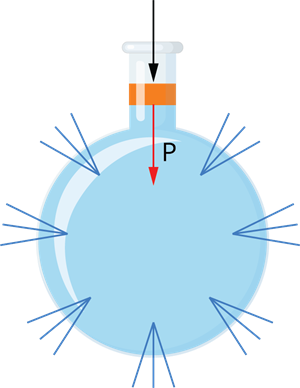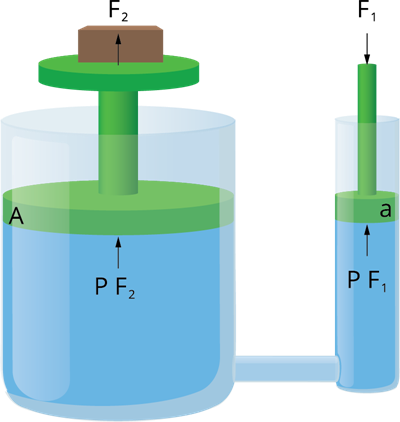
PUMPA - SMART LEARNING
எங்கள் ஆசிரியர்களுடன் 1-ஆன்-1 ஆலோசனை நேரத்தைப் பெறுங்கள். டாப்பர் ஆவதற்கு நாங்கள் பயிற்சி அளிப்போம்
Book Free DemoThe pascal's law states that the external pressure applied to an incompressible liquid is transmitted uniformly throughout the liquid.
Pascal's law is named after a French mathematician and physicist, Blaise Pascal (\(1623-1662\)). This law can be explained with the help of a glass container having holes all over its surface.
- Fill the container with water.
- Push the piston.
- The water rushes out of the openings in the vessel with the same pressure.
- The force applied on the piston exerts pressure on the water.
- This pressure is transferred equally throughout the liquid in all directions.
- We use this principle in various machines in our day to day life.

Exerts equal pressure
Hydraulic press:
Pascal's law became the foundation for one of the important machines ever developed, the hydraulic press. It consists of two cylinders with different cross-sectional areas. Cylinders are fitted with pistons of cross-sectional areas 'a' and 'A'. The object to be elevated is placed on the large cross-sectional area piston 'A'. Then, the force 'F1' is applied on the piston of the small cross-sectional area a. As a result, the pressure 'P' produced by a small piston is transmitted equally to a large piston, and a force 'F2' acts on 'A', which is much larger than 'F1'.

Picture depicts pascal's law
Pressure on piston of small area 'a' is given by
Pressure on piston of large area 'A' is given by
Comparing equation 1 and 2, we get
or
The ratio is greater than \(1\). Therefore, the force 'F2' that acts on the larger piston is greater than the force 'F1' acting on the smaller piston. Hydraulic system devices work in this way, and such devices are known as force multipliers.

Hydraulic press
Reference:
https://commons.wikimedia.org/wiki/File:Working_principle_of_a_hydraulic_jack.svg
https://commons.wikimedia.org/wiki/File:Pascal_law.jpg